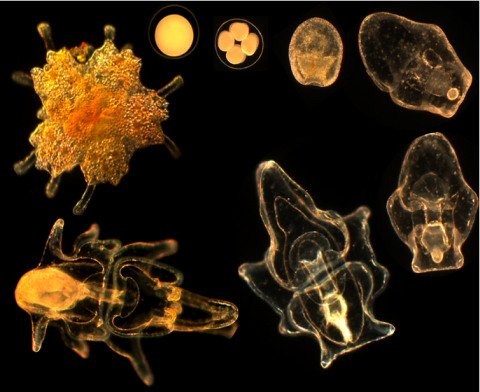Culturing crown-of-thorns larvae in the AIMS SeaSim
The Great Barrier Reef (GBR) is currently experiencing a 4th wave of crown-of-thorns seastar (Acanthaster planci) infestations since the 1960's. The seastars are spreading rapidly with reefs from Lizard Island to Cairns suffering massive coral mortality. The race is on again to learn more about the biology of COTS and fund some smart science to develop strategies that will miminise the coral loss caused by the voracious coral predator.
Metatdata - Crown-of-thorns densities and coral cover in 2013. Click on the 4-arrow square to go to the map page.
AIMS research since the 1980's has contributed significantly towards the understanding of COTS outbreaks, investigating diverse potential causes such as overfishing1 or increased larval survival due to eutrophication2 and developing methods to culture and settle the larvae3,4.
Culturing the crown of thorns larvae and rearing the juveniles in the SEASIM, the new large-scale aquarium system at AIMS is, providing a reliable source of experimental animals in an environment that can be manipulated to test the effects of temperature and other factors such as nutrients.
Project leader (NERP-TE 5.2) Dr Sven Uthicke said "The exceptional water quality in the SEASIM has been an important improvement in producing larval cultures with low mortality rates." He said his team have raised the larvae through their well-described larval stages and successfully settled the larvae. A batch of over 700 juveniles has now survived for 9 months in the system and is growing fast. These juveniles initially fed on coralline algae, and have recently switched to a coral diet.
Thanks to the success of the larval rearing program, scientists at AIMS are now undertaking several projects on the larval ecology of the seastar to contribute to the ultimate goal of understanding causes of COTS outbreaks and to prevent these in the future. Dr Uthicke said some experiments have already been completed. His team investigated the development of larvae under fine temperature control and showed the larvae have a clearly described 'thermal window' and a distinct temperature optimum close to current day temperature maxima5. A second study showed that ocean acidification does have negative impacts of COTS development ranging from reduced fertilisation rates to decreases of settlement on algae previously subjected to ocean acidification conditions6. However, they concluded that the overall effects of this are likely to be too small to prevent future COTS outbreaks.
Dr Uthicke said "In the SeaSim we can manipulate seawater to investigate wide-ranging questions important for management of Australia's seas such as the impacts of land-runoff, dredging and climate change." Given the success of the cultures, AIMS is continuing to support new research on larval ecology. Current and future projects range from the development of genetic methods to track larvae and the propagation of outbreaks in the field, to experiments determining important life history parameters needed to predict the causes and dynamics of crown-of-thorns infestations.
1. Sweatman, H. No-take reserves protect coral reefs from predatory starfish. Current Biology 18, R598-R599 (2008).
2. Fabricius, K. E., Okaji, K. & De'ath, G. Three lines of evidence to link outbreaks of the crown-of-thorns seastar Acanthaster planci to the release of larval food limitation. Coral Reefs 29, 593-605 (2010).
3. Keesing, J. K., Halford, A. R., Hall, K. C. & Cartwright, C. M. Large-scale laboratory culture of the crown-of-thorns starfish Acanthaster planci (L.) (Echinodermata: Asteroidea). Aquaculture 157, 215-226 (1997).
4. Johnson, C. & Sutton, D. Bacteria on the surface of crustose coralline algae induce metamorphosis of the crown-of-thorns starfish Acanthaster planci. Marine Biology 120, 305-310 (1994).
5. Lamare, M. et al. The thermal tolerance of crown-of-thorns (Acanthaster planci) embryos and bipinnaria larvae: implications for spatial and temporal variation in adult populations. Coral Reefs 33, 207–219, doi:DOI 10.1007/s00338-013-1112-3 (2014).
6. Uthicke, S. et al. Impacts of Ocean Acidification on Early Life-History Stages and Settlement of the Coral-Eating Sea Star Acanthaster planci. PLoS ONE 8, e82938, doi:10.1371/journal.pone.0082938 (2013).






